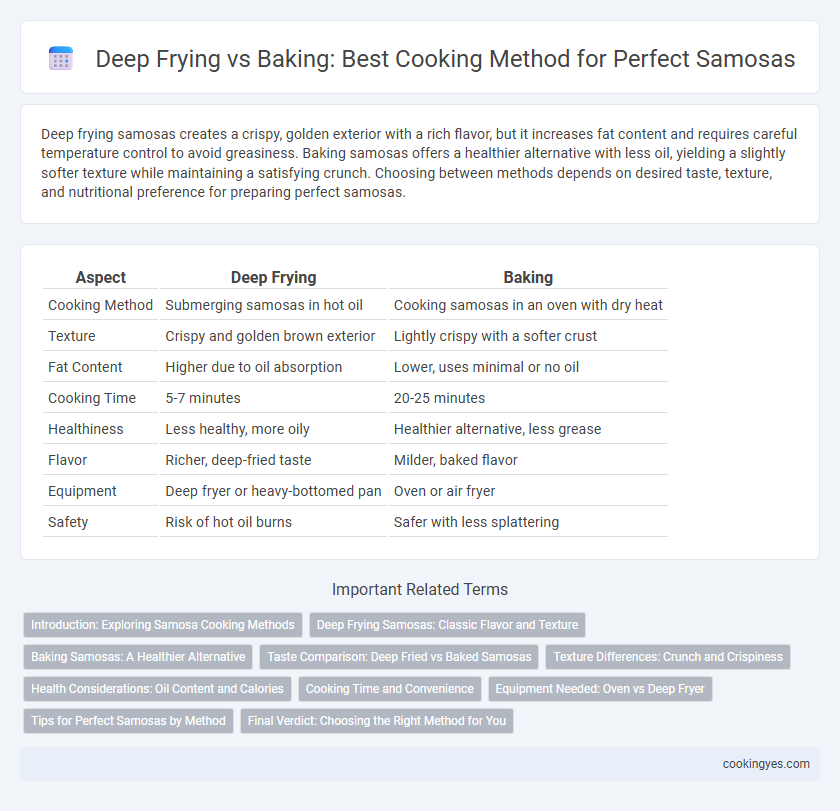Deep frying samosas creates a crispy, golden exterior with a rich flavor, but it increases fat content and requires careful temperature control to avoid greasiness. Baking samosas offers a healthier alternative with less oil, yielding a slightly softer texture while maintaining a satisfying crunch. Choosing between methods depends on desired taste, texture, and nutritional preference for preparing perfect samosas.
Table of Comparison
| Aspect | Deep Frying | Baking |
|---|---|---|
| Cooking Method | Submerging samosas in hot oil | Cooking samosas in an oven with dry heat |
| Texture | Crispy and golden brown exterior | Lightly crispy with a softer crust |
| Fat Content | Higher due to oil absorption | Lower, uses minimal or no oil |
| Cooking Time | 5-7 minutes | 20-25 minutes |
| Healthiness | Less healthy, more oily | Healthier alternative, less grease |
| Flavor | Richer, deep-fried taste | Milder, baked flavor |
| Equipment | Deep fryer or heavy-bottomed pan | Oven or air fryer |
| Safety | Risk of hot oil burns | Safer with less splattering |
Introduction: Exploring Samosa Cooking Methods
Deep frying samosas results in a crisp, golden exterior and a rich, indulgent flavor due to hot oil cooking, whereas baking offers a healthier alternative with less oil absorption and a lighter texture. The choice between deep frying and baking impacts not only the calorie content but also the samosa's crunchiness and overall taste profile. Understanding these cooking methods helps optimize samosa preparation for desired health benefits and sensory qualities.
Deep Frying Samosas: Classic Flavor and Texture
Deep frying samosas creates a crispy, golden-brown exterior that enhances their traditional flavor and provides a satisfying crunch. The hot oil rapidly cooks the pastry, sealing in the spiced filling while producing an evenly cooked texture with a characteristic rich aroma. This method remains the preferred choice for authentic samosas, delivering a balance of crunch and moisture that baking often cannot replicate.
Baking Samosas: A Healthier Alternative
Baking samosas significantly reduces oil absorption, resulting in lower fat content compared to traditional deep frying methods. This healthier alternative maintains the samosa's crispiness and flavor while promoting better cardiovascular health by minimizing trans fats. Nutrient retention also improves with baking, making it an optimal choice for health-conscious individuals seeking a guilt-free snack.
Taste Comparison: Deep Fried vs Baked Samosas
Deep fried samosas offer a crispy, golden exterior with a rich, indulgent flavor enhanced by the oil's infusion, creating a classic, savory taste profile. Baked samosas provide a lighter, less greasy alternative with a subtle crunch, preserving more of the filling's natural flavors without overpowering oiliness. Taste preference often hinges on desired texture and health considerations, as deep frying yields a traditional, robust flavor while baking results in a milder, fresher taste experience.
Texture Differences: Crunch and Crispiness
Deep frying samosas creates an evenly browned, golden crust with exceptional crunch and crispiness due to the hot oil sealing the outer layers quickly. Baking samosas results in a lighter, less oily texture, often with a slightly softer bite and less intense crispiness compared to deep frying. The Maillard reaction during deep frying enhances the samosa's crunch, while baking offers a healthier alternative with more subtle texture contrasts.
Health Considerations: Oil Content and Calories
Deep frying samosas significantly increases their oil content and calorie count, contributing to higher fat intake and potential cardiovascular risks. Baking samosas reduces oil absorption, lowering calories and making them a healthier alternative while maintaining a crispy texture. Opting for baked samosas helps control fat consumption and supports better weight management without sacrificing flavor.
Cooking Time and Convenience
Deep frying samosas typically takes 4 to 6 minutes until golden brown and crisp, offering quick results but requiring constant monitoring and a larger quantity of oil. Baking samosas takes longer, around 20 to 25 minutes at 375degF (190degC), providing a healthier option with less oil consumption and less hands-on attention. Choosing between deep frying and baking depends on balancing the need for faster cooking time and the convenience of a less messy process.
Equipment Needed: Oven vs Deep Fryer
Deep frying samosas requires a deep fryer or a heavy-bottomed pot filled with oil maintained at 350-375degF for crisp, evenly cooked results. Baking samosas needs an oven preheated to 375-400degF and a baking tray lined with parchment paper or a silicone mat to achieve a healthier, less oily finish. While deep fryers provide precise temperature control for perfect golden crusts, ovens offer a more convenient and energy-efficient option with minimal equipment cleanup.
Tips for Perfect Samosas by Method
For perfect samosas, deep frying is essential to achieve a crispy, golden-brown exterior and a moist, flavorful filling, with oil temperature maintained around 350degF to prevent sogginess or burning. When baking samosas, brushing them with oil or butter ensures a crisp texture, and baking at 375degF for 20-25 minutes, turning halfway, promotes even cooking. Using chilled dough and sealing edges properly reduces oil absorption in frying and prevents filling leakage during baking.
Final Verdict: Choosing the Right Method for You
Deep frying samosas yields a crispy, golden exterior and a rich flavor profile, favored for authentic texture and taste, while baking provides a healthier alternative with less oil absorption and a slightly lighter crispness. Consider dietary preferences, desired texture, and time efficiency when choosing between methods; deep frying is faster but higher in calories, whereas baking suits a health-conscious approach with less mess. The right method ultimately depends on balancing flavor intensity, nutritional goals, and convenience to match individual cooking priorities.
Deep frying vs Baking for Samosa cooking Infographic

 cookingyes.com
cookingyes.com